What Does a Customer Operations Manager Do

A customer operations manager plays a crucial role in shaping customer service operations. You ensure smooth processes, enabling businesses to deliver exceptional customer satisfaction. Companies that excel in customer experience often see 4-8% higher revenues, proving the financial impact of this role. By tracking service metrics like response times, you can identify inefficiencies and refine workflows. Tools like Sobot's Voice/Call Center amplify your efforts with features such as AI-powered voicebots and global call routing. These innovations reduce costs by up to 30%, offering 24/7 support and personalized service to elevate customer experiences.
Key Responsibilities of a Customer Operations Manager

Strategic Planning and Process Optimization
As a customer operations manager, you play a pivotal role in shaping the strategic direction of customer service operations. Strategic planning ensures that your team operates efficiently and aligns with broader business goals. Businesses with written plans grow 30% faster than those without, and 71% of fast-growing companies rely on strategic or business plans. This highlights the importance of having a clear roadmap for success.
| Evidence | Description |
|---|---|
| Growth Rate | Businesses with written plans grow 30% faster than those without. |
| Success Rate | Companies with a plan are more likely to succeed in the first few years. |
| Employee Commitment | Employees are more committed to a plan when it exists. |
| Fast-Growing Companies | 71% of fast-growing companies have strategic or business plans. |
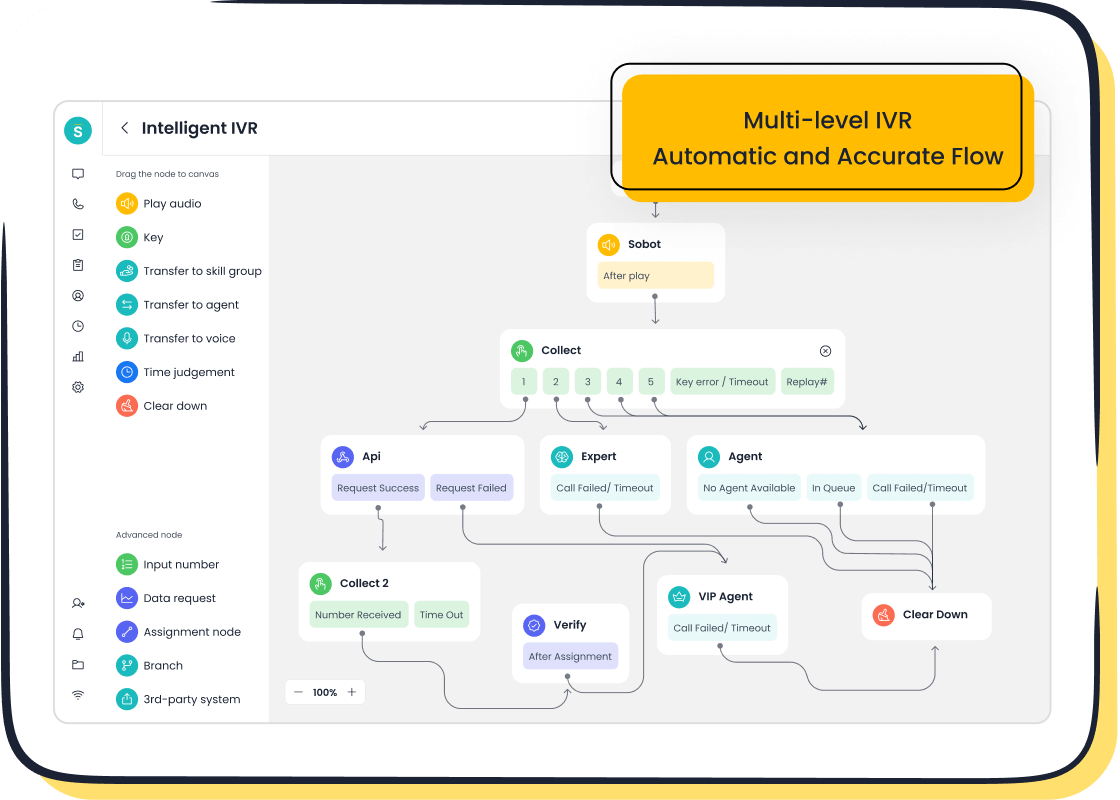
Process optimization is another critical aspect of your role. By analyzing metrics like customer satisfaction (CSAT), net promoter score (NPS), and first response time, you can identify inefficiencies and implement improvements. For example, tools like Sobot's Voice/Call Center streamline workflows with features such as intelligent IVR and smart call routing. These innovations reduce average ticket handling time and improve first-contact resolution rates, ensuring a seamless customer experience.
Tip: Regularly review your processes and use data-driven insights to refine them. This approach not only enhances efficiency but also boosts customer satisfaction.
Team Management and Leadership
Effective team management is at the heart of your responsibilities. You must inspire and guide your team of customer service representatives to deliver exceptional service. Empowering employees to make decisions without delays improves service efficiency and reduces customer frustration. For instance, 68% of customers value polite and proactive service, while 72% get annoyed when they have to explain their issues multiple times.
| Evidence Description | Statistic |
|---|---|
| Customers who value polite service | 68% |
| Customers annoyed by being passed around | 72% |
| Average time consumers will wait on hold | 11 minutes before hanging up |
| Customers expecting specialized treatment | 48% |
| Customers wanting action on feedback | 52% |
| Customers appreciating proactive notifications | 68% |
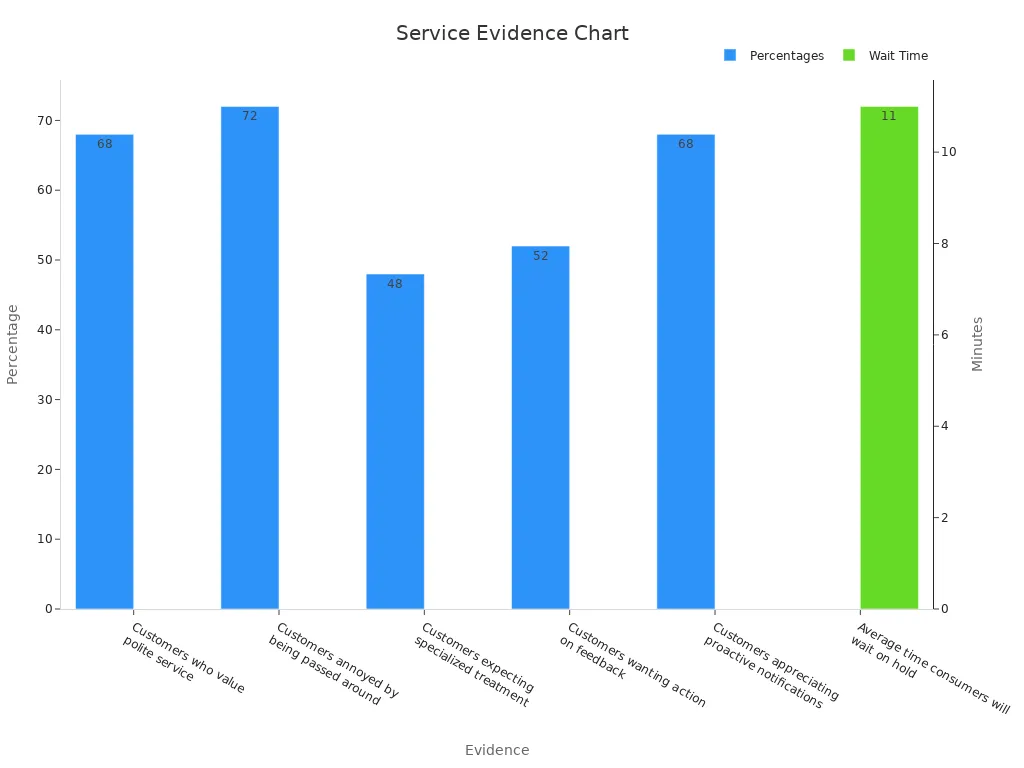
Leadership also involves fostering a culture of accountability and continuous improvement. By leveraging tools like Sobot's unified workspace, you can provide your team with the resources they need to excel. This platform consolidates customer data, enabling agents to resolve issues more effectively and deliver personalized service.
Note: Regular training sessions and performance reviews can help your team stay aligned with customer service strategies and goals.
Enhancing Customer Service Operations
Enhancing customer service operations involves implementing strategies that improve efficiency and customer satisfaction. Operational enhancements can lead to a 23% increase in overall customer satisfaction and an 18% reduction in customer attrition rates. These improvements not only strengthen customer loyalty but also reduce costs associated with acquiring new customers.
| Outcome Description | Improvement Percentage | Source |
|---|---|---|
| Overall customer satisfaction increase | 23% | J.D. Power, 2023 |
| Reduced customer attrition rates | 18% | J.D. Power, 2023 |
| Increased share of wallet | 7.5% | J.D. Power, 2023 |
| Decreased customer acquisition costs | 24% | J.D. Power, 2023 |
| Increase in customer satisfaction (lending) | 41% | Fannie Mae Mortgage Lender Sentiment Survey, 2023 |
| Improvement in completed applications | 28% | Fannie Mae Mortgage Lender Sentiment Survey, 2023 |
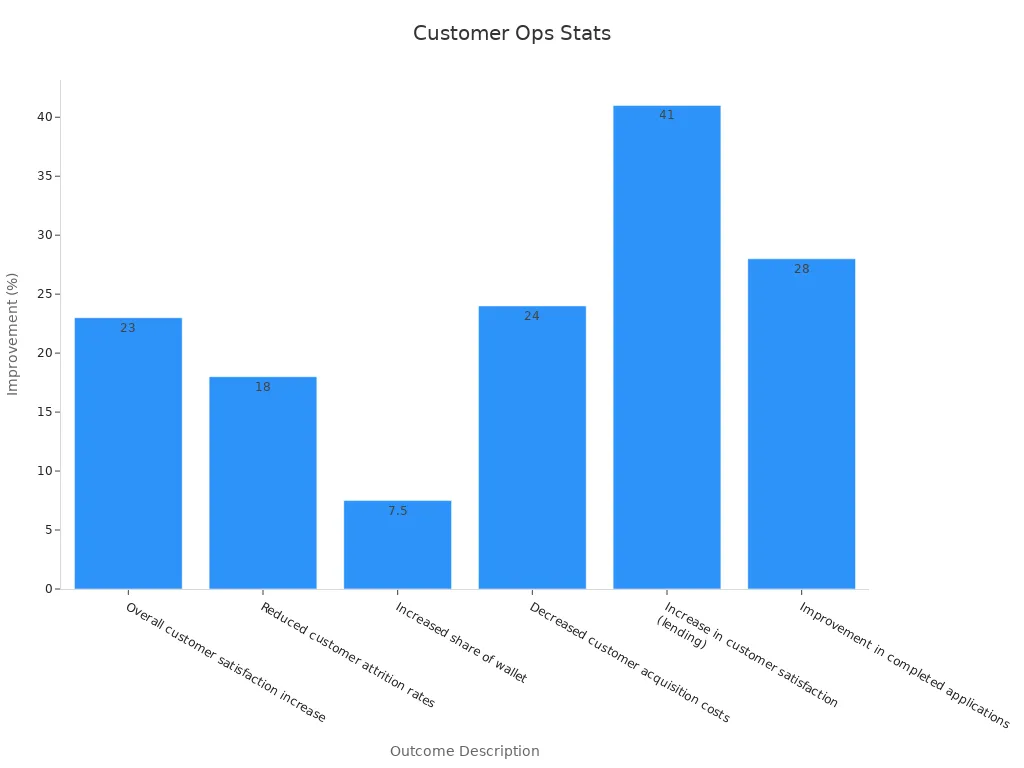
Sobot's solutions, such as the Omnichannel platform, can significantly enhance your operations. This platform integrates multiple communication channels, allowing you to provide seamless support across voice, email, and social media. By automating repetitive tasks with AI-driven chatbots, you can free up your team to focus on complex issues, ultimately improving customer satisfaction and operational efficiency.
Tip: Use analytics tools to monitor performance and identify areas for improvement. Metrics like first response time and resolution rates can provide valuable insights into your team's effectiveness.
Performance Monitoring and Reporting
Performance monitoring is essential for ensuring the success of customer service operations. As a customer operations manager, you track key metrics to evaluate how well your team meets customer expectations. Metrics like customer satisfaction (CSAT) and net promoter score (NPS) provide insights into customer happiness and loyalty. For example, CSAT surveys reveal how satisfied customers are with your service, while NPS gauges their likelihood of recommending your business.
| Performance Indicator | Description |
|---|---|
| Customer Satisfaction (CSAT) | Evaluates customer happiness through feedback or survey results. |
| Net Promoter Score (NPS) | Assesses customer loyalty by gauging how likely they are to recommend your product or service. |
| Customer Holding Rate | Monitors the percentage of customers who continue their relationship with the business over time. |
| On-Time Delivery Performance | Tracks the efficiency of delivering goods or services to clients within the promised timeframe. |
| Customer Lifetime Value (CLV) | Projects the total revenue a customer is expected to generate throughout their relationship. |
Monitoring these indicators allows you to identify areas for improvement. For instance, if CSAT scores drop, you can investigate the root cause and implement corrective measures. Tools like Sobot's Voice/Call Center simplify this process by providing real-time analytics and call tracking. These features help you monitor agent performance and customer interactions, ensuring your team delivers consistent, high-quality service.
Reporting complements monitoring by translating data into actionable insights. Regular reports help you communicate progress to stakeholders and align your team with organizational goals. For example, sharing NPS trends with your team can motivate them to improve customer loyalty. By leveraging Sobot's unified workspace, you can generate detailed reports that highlight performance metrics and operational efficiency.
Tip: Use automated reporting tools to save time and ensure accuracy. This approach allows you to focus on strategic improvements rather than manual data compilation.
Collaboration with Cross-Functional Teams
Collaboration with cross-functional teams is vital for optimizing customer service operations. As a customer operations manager, you work closely with departments like sales, marketing, and product development to ensure seamless communication and shared goals. This collaboration enhances knowledge sharing, allowing teams to contribute their expertise to improve customer experiences.
| Benefit | Description |
|---|---|
| Enhanced Communication | Involves representatives from different departments, ensuring everyone is aware of project progress. |
| Innovation and Diverse Solutions | Brings together multiple perspectives, leading to unique insights and creative solutions. |
| Streamlined Processes | Reduces duplicate work and focuses accountability on the group, improving efficiency. |
| Improved Employee Engagement | Fosters new interactions among team members, boosting engagement through shared goals. |
For example, sales teams can share customer feedback with marketing teams to create targeted campaigns. Similarly, product teams can use insights from customer service to refine product features. This collaboration not only improves operational efficiency but also drives innovation.
Sobot's Omnichannel Solution facilitates cross-functional collaboration by integrating communication channels and customer data into a unified platform. This integration ensures that all teams have access to the same information, reducing miscommunication and improving decision-making. By using tools like AI-driven chatbots, you can automate repetitive tasks, freeing up your team to focus on strategic initiatives.
Note: Regular cross-departmental meetings can strengthen collaboration and ensure alignment on customer service goals.
Essential Customer Operations Manager Skills
Leadership and Communication Skills
Strong leadership and effective communication are essential skills for a customer operations manager. You need to inspire your team and foster collaboration to achieve common goals. Clear communication ensures employees understand their roles and organizational objectives, boosting morale and job satisfaction. For example, when leaders prioritize transparency, employees feel valued and confident, leading to higher productivity and engagement.
| Key Findings | Implications |
|---|---|
| Trust is essential for managerial support in manufacturing. | Leadership must foster trust among stakeholders. |
| Managerial behavior and communication drive sustainable performance. | Effective communication enhances leadership roles. |
| A trustworthy environment improves management effectiveness. | Leadership should focus on building trust to boost productivity. |
| Worker wellbeing links to organizational success. | Leaders must prioritize employee engagement and wellbeing. |
Effective communication also builds rapport and trust within your team. Open forums and anonymous feedback sessions allow employees to share concerns and ideas, creating a positive work culture. Tools like Sobot’s unified workspace can enhance communication by providing a centralized platform for managing customer interactions and team collaboration.
Tip: Regularly engage with your team through active listening and follow-up mechanisms to address feedback. This approach strengthens trust and improves team performance.
Problem-Solving and Decision-Making Abilities
Problem-solving and decision-making are critical for navigating challenges in customer service operations. As a customer operations manager, you must evaluate situations quickly and implement solutions that align with organizational goals. Decision matrices, cost-benefit analyses, and SWOT frameworks help you prioritize options and mitigate risks effectively.
| Decision-Making Frameworks | Description |
|---|---|
| Decision Matrices | Evaluates and prioritizes options systematically. |
| Cost-Benefit Analysis | Compares costs and benefits of potential solutions. |
| SWOT Analysis | Identifies strengths, weaknesses, opportunities, and threats. |
| Risk Assessments | Anticipates risks and mitigates negative consequences. |
For example, when faced with high customer attrition rates, you can use data analytics to identify root causes and implement targeted strategies. Sobot’s Voice/Call Center provides real-time monitoring and analytics, enabling you to track key metrics like customer satisfaction and resolution rates. These insights help you make informed decisions that improve service efficiency and customer retention.
Note: Always evaluate the impact of your decisions on both short-term and long-term organizational goals.
Analytical and Data-Driven Mindset
An analytical mindset is vital for optimizing customer service operations. Organizations that adopt data-driven approaches are 300% more likely to report significant improvements in decision-making. By analyzing customer behavior and preferences, you can identify bottlenecks and refine processes to enhance efficiency.
- Enhanced Decision-Making: Reduces biased choices by relying on objective insights.
- Improved Efficiency: Identifies operational inefficiencies and optimizes workflows.
- Better Customer Understanding: Provides actionable insights into customer needs and preferences.
For instance, a telecommunications company used simulation modeling to optimize field service operations, resulting in increased revenue and reduced expenses. Similarly, Sobot’s AI-powered Voicebot automates repetitive tasks, freeing up your team to focus on complex customer issues. This integration of advanced analytics and AI capabilities improves customer satisfaction and operational outcomes.
Tip: Establish a robust data platform to integrate various data sources. Use analytics to guide product development and innovation, ensuring your strategies align with customer needs.
Customer-Centric Approach
A customer-centric approach places the customer at the heart of every decision you make as a customer operations manager. This mindset ensures that your strategies align with customer needs, leading to better service outcomes and stronger relationships. Customers today expect businesses to care about their experiences. In fact:
- 62% of consumers believe businesses need to care more about them.
- 60% of consumers are willing to spend more if they feel valued.
When you prioritize customer satisfaction, you create a ripple effect. Happy customers are more likely to return, recommend your services, and even pay a premium for exceptional experiences. Research shows that 86% of buyers are willing to pay more for fantastic customer service. Brands that adopt a personalized approach can generate 40% more revenue compared to those that don’t.
To implement this approach effectively, you must understand your customers deeply. Tools like Sobot’s Omnichannel Solution can help you achieve this by consolidating customer data from multiple channels into a unified workspace. This integration allows you to personalize interactions, whether through email, social media, or voice calls. For example, you can use Sobot’s AI-powered Voicebot to address repetitive queries, freeing your team to focus on more complex issues.
Customer loyalty programs also play a key role in evaluating the success of your customer-centric strategies. By analyzing changes in purchase amounts and transaction frequency, you can measure how well your efforts resonate with your audience.
Tip: Always listen to customer feedback. Use it to refine your processes and demonstrate that you genuinely care about their needs.
Time Management and Organizational Skills
Time management and organizational skills are essential for excelling as a customer operations manager. These skills allow you to prioritize tasks, meet deadlines, and ensure your team operates efficiently. Poor time management can lead to missed opportunities and dissatisfied customers.
Start by organizing your daily responsibilities. Break down larger tasks into smaller, manageable steps. For instance, if you’re overseeing a new customer service initiative, create a timeline with clear milestones. This approach keeps you on track and ensures that every aspect of the project receives attention.
Using technology can further enhance your efficiency. Sobot’s Voice/Call Center offers features like smart call routing and real-time monitoring, which streamline workflows and reduce response times. These tools help you allocate resources effectively, ensuring that your team focuses on high-priority tasks.
Another key aspect of time management is delegation. Assigning tasks to the right team members not only lightens your workload but also empowers your team to take ownership of their roles. This fosters a sense of accountability and boosts overall productivity.
Note: Regularly review your schedule and adjust priorities as needed. Flexibility ensures that you can adapt to unexpected challenges without compromising on quality.
Tools and Technologies for Customer Service Operations

Customer Relationship Management (CRM) Software
CRM software plays a vital role in managing customer relationships and streamlining operations. It helps you track customer interactions, predict demand, and optimize your team's effectiveness. For example, CRM systems provide a constantly updated customer history, enabling you to personalize marketing efforts and simplify the purchasing process. Businesses using mobile CRM systems report a 150% higher likelihood of exceeding sales goals.
| Statistic | Value |
|---|---|
| Projected CRM market growth | 12% annually through 2028 |
| Expected market size by 2028 | $129 billion |
| Businesses using CRM for customer service | 35% |
| Improved customer satisfaction | 71% |
| Increased sales revenue | 67% |
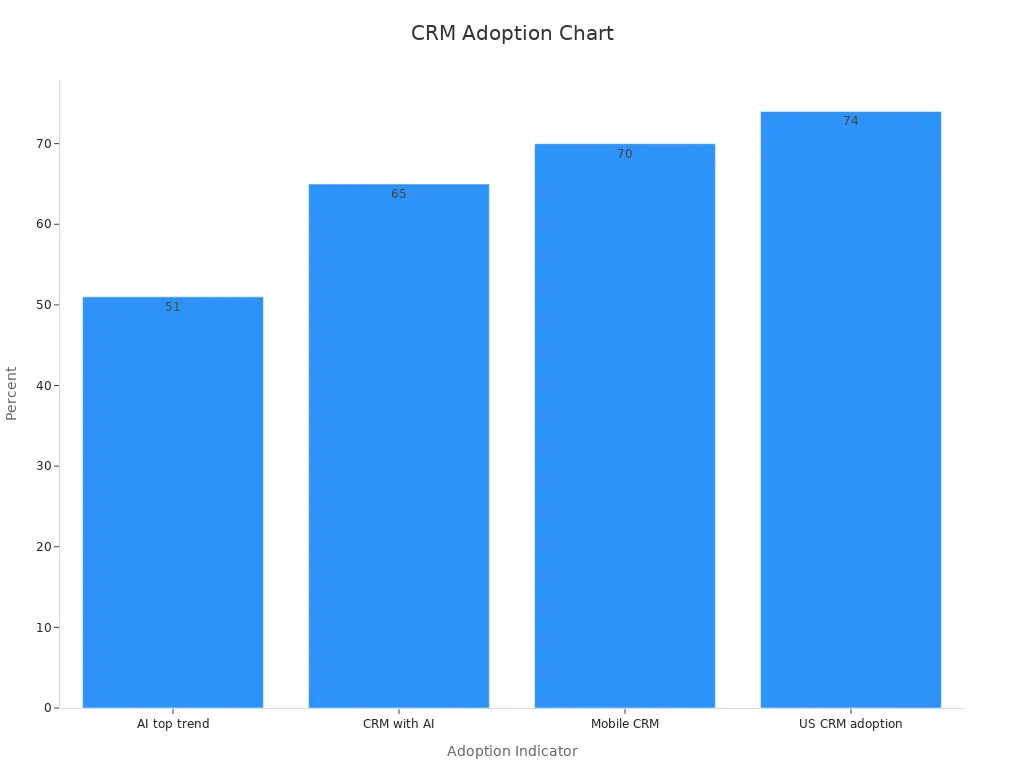
By adopting CRM software, you can enhance customer satisfaction and retention while saving time through automation. These tools also improve team collaboration, making them indispensable for modern customer service operations.
Workforce Management Tools
Workforce management tools help you allocate resources effectively and ensure your team operates at peak efficiency. These tools allow you to forecast demand, schedule shifts, and monitor performance in real time. For example, they can identify peak hours and adjust staffing levels accordingly, reducing wait times and improving customer satisfaction.
Quantitative analysis shows that businesses using such tools uncover actionable insights, streamline operations, and strengthen their competitive positioning. By integrating workforce management tools with CRM systems, you can further optimize your processes and deliver exceptional service.
Tip: Use workforce management tools to track key metrics like average handle time and first-contact resolution rates. This data helps you make informed decisions and improve overall efficiency.
Sobot's Voice/Call Center for Streamlined Communication
Sobot's Voice/Call Center offers a comprehensive solution for managing customer interactions. Its features, such as intelligent IVR and AI-powered voicebots, reduce inbound inquiries by 20% and improve customer satisfaction to 95%. The platform also provides real-time monitoring and analytics, enabling you to track performance and refine workflows.
| Improvement Metric | Percentage/Score |
|---|---|
| Reduction in inbound inquiries | 20% |
| Increase in positive feedback | 96%+ |
| Customer satisfaction score (CSAT) | 97% |
| Problems solved | 85% |
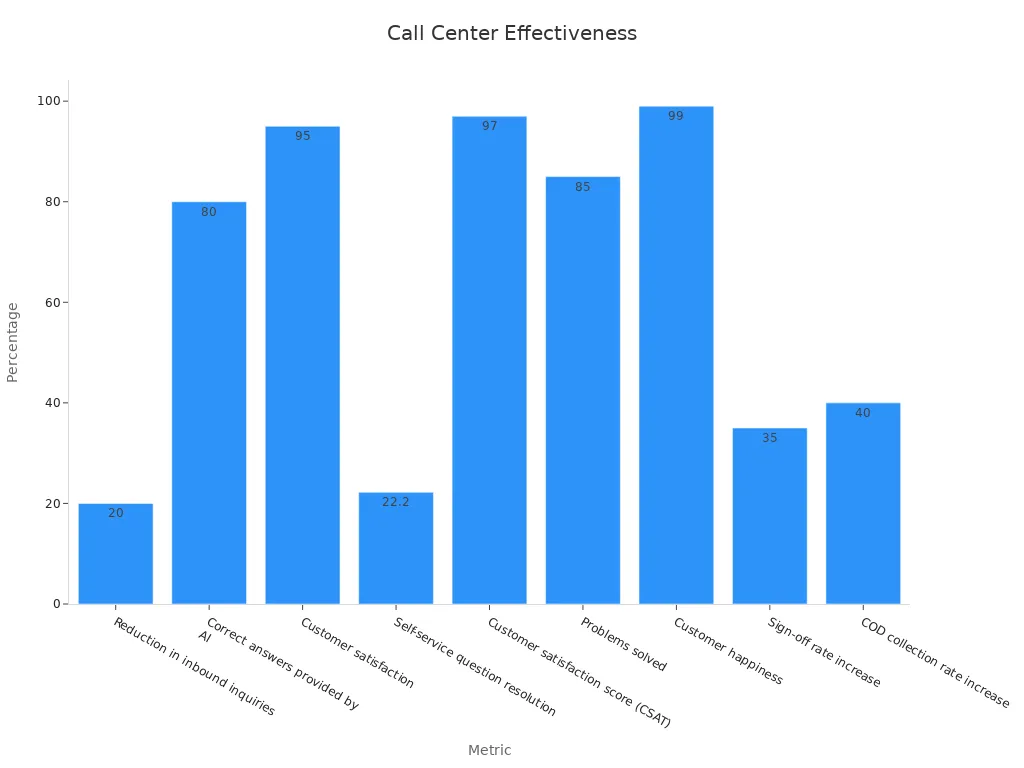
With global call routing and a 99.99% uptime, Sobot's solution ensures seamless communication across time zones. By automating repetitive tasks, it frees up your team to focus on complex issues, ultimately enhancing customer service operations.
Data Analytics and Reporting Platforms
Data analytics and reporting platforms are essential tools for improving customer service operations. These platforms help you track performance metrics, identify trends, and make data-driven decisions. For example, analyzing customer satisfaction (CSAT) scores can reveal areas where your team excels and where improvements are needed. Businesses that use analytics tools report a 23% increase in operational efficiency, according to McKinsey.
You can use these platforms to monitor metrics like first response time, resolution rates, and customer retention. Real-time dashboards provide instant insights, allowing you to address issues before they escalate. Sobot’s Voice/Call Center offers advanced analytics features, including call tracking and performance monitoring. These tools help you evaluate agent productivity and customer interactions, ensuring consistent service quality.
Tip: Use predictive analytics to anticipate customer needs. This approach improves satisfaction and reduces churn rates.
Reporting platforms complement analytics by transforming raw data into actionable insights. Automated reports save time and ensure accuracy. For instance, Sobot’s unified workspace generates detailed reports that highlight trends in customer behavior and operational efficiency. These insights help you refine strategies and align your team with organizational goals.
Knowledge Management Systems
Knowledge management systems (KMS) play a crucial role in empowering your team and enhancing customer service. These systems store and organize information, making it easily accessible to agents. A well-maintained KMS reduces average handling time by up to 35%, according to Forrester.
You can use KMS to provide agents with quick access to FAQs, troubleshooting guides, and customer histories. This ensures faster resolutions and improves customer satisfaction. Sobot’s Omnichannel Solution integrates seamlessly with knowledge management systems, offering a unified workspace where agents can access all relevant information.
Note: Regularly update your KMS to ensure accuracy and relevance. Outdated information can lead to inefficiencies and customer dissatisfaction.
By leveraging KMS, you create a centralized hub for knowledge sharing. This fosters collaboration and ensures your team delivers consistent, high-quality service.
Career Path for a Customer Operations Manager
Entry-Level Roles Leading to the Position
Starting your journey as a customer operations manager often begins with entry-level roles that build foundational skills. Positions like Operations Coordinator or Customer Service Representative provide hands-on experience in managing customer interactions and understanding operational workflows. These roles teach you how to handle customer inquiries, resolve issues, and maintain service quality.
As you gain experience, you can progress to roles such as Operations Supervisor or Team Lead. These positions involve overseeing small teams, monitoring performance, and implementing process improvements. They prepare you for the strategic and leadership responsibilities of a customer operations manager.
| Role | Salary Range |
|---|---|
| Operations Coordinator | $37,687 - $62,860 |
| Operations Supervisor | $43,627 - $81,080 |
| Operations Manager | $55,897 - $130,058 |
| Director of Operations | $72,500 - $154,982 |
| Vice President of Operations | $120,000 - $200,000 |
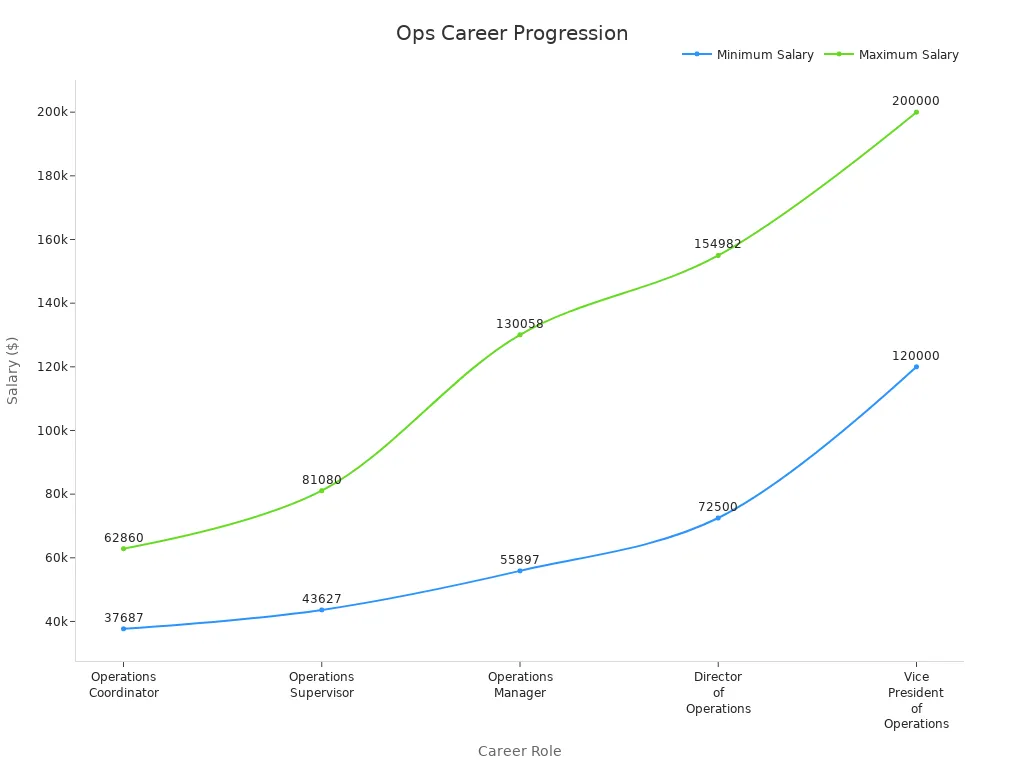
These roles not only enhance your skills but also increase your earning potential. For example, the average customer operations manager salary ranges from $55,897 to $130,058, depending on experience and location.
Growth Opportunities and Senior Roles
Customer operations manager jobs offer significant growth opportunities. With experience, you can advance to senior roles like Director of Operations or Vice President of Operations. These positions involve strategic decision-making, cross-departmental collaboration, and overseeing large-scale customer service initiatives.
In senior roles, you may focus on implementing advanced technologies like AI-powered tools to optimize customer interactions. For instance, Sobot’s Voice/Call Center can streamline communication and improve operational efficiency, making it a valuable asset for leaders aiming to enhance customer satisfaction.
Leadership roles also allow you to influence company policies and drive innovation. By leveraging data analytics and customer insights, you can develop strategies that align with organizational goals and improve service quality.
Industries and Sectors with High Demand
The demand for customer operations manager jobs spans various industries. Sectors like retail, financial services, and technology prioritize customer experience to retain clients and build brand loyalty. The increasing adoption of AI and cloud-based technologies has further amplified the need for skilled managers who can navigate these advancements.
Omnichannel solutions are becoming essential for businesses aiming to provide seamless customer experiences. Companies now integrate communication channels like voice, email, and social media to meet customer expectations. This trend highlights the importance of professionals who can manage these complex systems effectively.
For example, Sobot’s Omnichannel Solution enables businesses to unify customer interactions across platforms, ensuring consistent and personalized service. This capability is crucial in competitive markets where customer retention depends on exceptional service.
Tip: Explore industries that emphasize customer experience and invest in technologies like AI and automation. These sectors often offer lucrative opportunities and career growth.
Certifications and Training Programs
Certifications and training programs help you build credibility and enhance your skills as a customer operations manager. Employers often look for candidates with specialized knowledge in customer service, operations management, and leadership. Certifications validate your expertise and demonstrate your commitment to professional growth.
Some popular certifications include:
- Certified Customer Service Manager (CCSM): This certification focuses on customer service strategies and leadership skills.
- Project Management Professional (PMP): PMP certification equips you with project management techniques that improve operational workflows.
- Six Sigma Green Belt: This program teaches you how to optimize processes and reduce inefficiencies.
- Customer Experience Specialist (CXS): CXS certification emphasizes customer-centric strategies and data-driven decision-making.
Training programs also play a vital role in your career development. Many organizations offer workshops and online courses tailored to customer operations manager training. For example, platforms like Coursera and LinkedIn Learning provide courses on customer service analytics, team management, and communication skills.
Sobot’s solutions, such as the Voice/Call Center, can complement your training by offering hands-on experience with advanced tools. Features like AI-powered voicebots and real-time analytics help you understand how technology improves customer interactions and operational efficiency.
Tip: Research certifications that align with your career goals. Choose programs that focus on leadership, analytics, and customer-centric strategies.
Tips for Advancing in the Field
Advancing in the field of customer operations management requires strategic planning and continuous learning. Start by setting clear career goals. Identify areas where you need improvement, such as leadership or data analysis, and seek opportunities to develop those skills.
Networking is another powerful tool. Attend industry events, webinars, and workshops to connect with professionals who can offer guidance and mentorship. Building relationships with experienced managers helps you gain insights into best practices and emerging trends.
Hands-on experience is equally important. Take on challenging projects that allow you to showcase your problem-solving abilities. For example, implementing Sobot’s Omnichannel Solution in your organization can demonstrate your ability to streamline workflows and enhance customer satisfaction.
Stay updated on industry trends. Subscribe to blogs, follow thought leaders, and explore new technologies like AI and automation. These advancements are reshaping customer service operations, and understanding them will give you a competitive edge.
Note: Regularly evaluate your progress. Use feedback from peers and supervisors to refine your strategies and achieve your career objectives.
Best Practices for Aspiring Customer Operations Managers
Building a Strong Foundation in Customer Service
Building a solid foundation in customer service is essential for long-term success in customer service operations. Exceptional service fosters loyalty, reduces churn, and drives business growth. Research shows that 45% of customer experience (CX) leaders report a high impact of customer service on loyalty, while 57% of customers are likely to switch brands after a single bad experience.
| Statistic | Description |
|---|---|
| 45% | CX leaders indicating high impact of customer experience on loyalty. |
| 57% | Customers likely to switch due to a single bad experience, increasing annually. |
| 42% | CX leaders reporting high impact of customer experience on business growth. |
To build this foundation, focus on understanding customer needs and delivering consistent, high-quality service. Tools like Sobot’s Omnichannel Solution can help unify communication channels, ensuring seamless interactions across platforms. By leveraging AI-driven chatbots, you can automate repetitive tasks and free up your team to address complex issues. This approach not only enhances customer satisfaction but also strengthens operational efficiency.
Tip: Regularly train your team on customer service best practices. Empower them with tools and knowledge to handle inquiries effectively and maintain service excellence.
Developing Leadership and Analytical Skills
Leadership and analytical skills are critical for aspiring customer operations managers. Strong leadership inspires teams to perform at their best, while analytical skills enable you to make data-driven decisions. Continuous learning plays a vital role in honing these abilities.
- Continuous learning helps teams adapt to current demands and future challenges.
- Investing in upskilling creates a robust team capable of delivering exceptional service.
- Development enables teams to embrace new technologies and evolving customer expectations.
For example, using Sobot’s Voice/Call Center, you can analyze call data to identify trends and improve workflows. Features like real-time monitoring and AI-powered voicebots provide actionable insights, helping you refine strategies and enhance team performance.
Note: Encourage your team to participate in workshops and certifications. This fosters a culture of innovation and ensures everyone stays ahead of industry trends.
Staying Updated on Industry Trends and Tools
Staying informed about industry trends and tools keeps you competitive in customer service operations. Emerging technologies like AI and automation are transforming how businesses interact with customers. For instance, AI-powered solutions reduce response times and improve personalization, leading to higher customer satisfaction.
Sobot’s products, such as the Voice/Call Center and Omnichannel Solution, exemplify these advancements. They integrate AI-driven features to streamline workflows and unify customer interactions. By adopting such tools, you can enhance service quality and operational efficiency.
Tip: Subscribe to industry blogs, attend webinars, and follow thought leaders to stay updated. Regularly evaluate new tools and technologies to ensure your strategies align with evolving customer expectations.
Networking and Learning from Industry Professionals
Networking plays a vital role in advancing your career as a customer operations manager. Building connections with industry professionals helps you gain insights into best practices, emerging trends, and innovative tools. Attending conferences, webinars, and workshops allows you to meet experts who can guide you in your professional journey. For example, events like the Customer Service & Experience Summit provide opportunities to learn from leaders in the field.
You can also join online communities and forums dedicated to customer service operations. Platforms like LinkedIn offer groups where professionals share experiences and discuss challenges. Engaging in these discussions helps you stay updated on industry developments. Additionally, seeking mentorship from experienced managers can provide valuable advice tailored to your career goals.
Sobot’s blog and resources can serve as a learning hub. By exploring case studies like OPPO’s success story, you can understand how companies optimize customer service operations using tools like Sobot’s Omnichannel Solution. This knowledge equips you to implement similar strategies in your role.
Tip: Make networking a regular habit. Dedicate time each month to connect with professionals, attend events, or participate in online discussions. These efforts will expand your knowledge and open doors to new opportunities.
Gaining Hands-On Experience in Operations Management
Practical experience is essential for mastering customer operations management. Hands-on involvement allows you to apply theoretical knowledge to real-world scenarios. Start by taking on projects that involve process optimization, team management, or performance monitoring. These tasks help you develop critical skills like problem-solving and decision-making.
Internships or entry-level roles in customer service provide an excellent starting point. For instance, working as a customer service representative teaches you how to handle inquiries and resolve issues efficiently. As you progress, seek opportunities to lead small teams or manage specific aspects of operations.
Using advanced tools like Sobot’s Voice/Call Center can enhance your learning experience. Features such as real-time monitoring and AI-powered voicebots allow you to understand how technology improves efficiency and customer satisfaction. By experimenting with these tools, you gain insights into optimizing workflows and delivering exceptional service.
Note: Document your experiences and reflect on what you learn. This practice helps you identify areas for improvement and track your growth as a professional.
A customer operations manager plays a vital role in ensuring customer satisfaction and operational success. By focusing on strategic planning, process optimization, and team collaboration, you can create a seamless customer service experience. For instance, analyzing customer data and acting on feedback helps refine workflows and improve service delivery.
| Key Responsibilities | Description |
|---|---|
| Strategic Planning and Execution | Develops strategies to enhance customer satisfaction and operational efficiency. |
| Process Optimization | Improves processes to streamline operations and enhance customer experiences. |
| Data Analysis and Reporting | Uses customer data to inform decisions and improve service delivery. |
| Technology Management | Leverages tools to manage customer relationships and workflows effectively. |
| Team Collaboration and Support | Aligns teams to achieve customer success initiatives. |
| Customer Feedback Loop | Implements systems to gather and act on feedback for continuous improvement. |
| Training and Onboarding | Equips team members to meet customer needs and expectations. |
Success in this role requires mastering essential skills like leadership, problem-solving, and time management. Tools like Sobot’s Voice/Call Center simplify operations by automating repetitive tasks and providing real-time analytics. These features enhance customer retention and satisfaction while empowering you to deliver exceptional customer service. Continuous learning and adopting advanced technologies ensure you stay ahead in this dynamic field.
Tip: Leverage tools like Sobot’s solutions to unify communication channels and optimize workflows. These innovations help you achieve operational excellence and build lasting customer relationships.
FAQ
What is the primary role of a Customer Operations Manager?
A Customer Operations Manager ensures smooth customer service operations. You focus on improving processes, managing teams, and enhancing customer satisfaction. Tools like Sobot’s Voice/Call Center help streamline workflows, reduce response times, and improve first-contact resolution rates, making your role more efficient.
How can Sobot’s solutions benefit customer service operations?
Sobot’s solutions, such as the Voice/Call Center, offer features like AI-powered voicebots, smart call routing, and real-time analytics. These tools reduce costs by up to 30%, improve customer satisfaction, and ensure seamless communication across channels. They also help you manage global operations with a 99.99% uptime.
What skills are essential for excelling as a Customer Operations Manager?
You need strong leadership, problem-solving, and analytical skills. A customer-centric mindset and time management are also crucial. Tools like Sobot’s Omnichannel Solution enhance these skills by unifying customer data and automating repetitive tasks, allowing you to focus on strategic improvements.
How do tools like Sobot’s Voice/Call Center improve team performance?
Sobot’s Voice/Call Center provides a unified workspace, real-time monitoring, and intelligent IVR. These features help your team handle inquiries efficiently, reduce average handling time, and improve first-contact resolution rates. This leads to better customer experiences and higher team productivity.
What industries benefit most from Sobot’s customer service solutions?
Industries like retail, financial services, and gaming benefit significantly. For example, OPPO used Sobot’s chatbot and ticketing system to achieve an 83% chatbot resolution rate and a 57% increase in repurchase rates. These solutions enhance efficiency and customer satisfaction across various sectors.
See Also
Essential Strategies for Effective Call Center Quality Management
Ten Key Actions for Successful Omnichannel Contact Centers
Comprehensive Overview of Quality Management Systems in Call Centers
Transforming Customer Support with AI-Powered Service Agents
Enhancing Call Center Efficiency Through Effective Performance Monitoring
